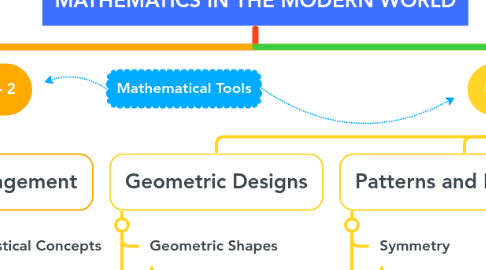
1. Created By: Toting, Bianca Nicole M.
2. CONCEPT MAP
3. Translations
4. ULO - 1
4.1. The Nature of Mathematics
4.1.1. Mathematics in Our World
4.1.1.1. Patterns and Numbers in Nature and the World
4.1.1.1.1. Patterns in Nature
4.1.1.1.2. Number Patterns
4.1.1.2. Appreciation of Numbers
4.1.1.3. The Fibonacci Sequence
4.1.1.4. The Golden Ratio
4.1.2. Mathematical Language and Symbols
4.1.2.1. The Mathematical Language
4.1.2.1.1. Mathematical Symbol
4.1.2.1.2. Mathematical Statements/Sentences
4.1.2.1.3. Variables
4.1.3. Reasoning and Problem-Solving
4.1.3.1. Reasoning
4.1.3.1.1. Inductive
4.1.3.1.2. Deductive
4.1.3.2. Proofs
4.1.3.2.1. Direct
4.1.3.2.2. Proof by Contradiction
4.1.3.3. Polya's Four-Step Approach
4.1.3.3.1. 1. Understand the problem
4.1.3.3.2. 2. Devise a Plan
4.1.3.3.3. 3. Carry out the Plan
4.1.3.3.4. 4. Look back
5. English Sentences
6. ULO - 2
6.1. Data Management
6.1.1. Basic Statistical Concepts
6.1.1.1. Statistics
6.1.1.2. Variables
6.1.1.3. Levels of Data Measurement
6.1.1.4. Data Presentation
6.1.2. Measures of Central Tendency
6.1.2.1. Arithmetic Mean
6.1.2.2. Median
6.1.2.3. Mode
6.1.3. Measures of Dispersion
6.1.3.1. Range
6.1.3.2. Variance
6.1.3.3. Standard Deviation
6.1.4. Measures of Relative Position
6.1.4.1. Percentiles
6.1.4.2. Quartiles
6.1.4.3. Standard Scores
6.1.5. Normal Distribution
6.1.5.1. Standard Normal Distribution
6.1.6. Correlation and Linear Regression
6.1.6.1. Least-Square Regression Line
6.1.6.2. Scatterplot
7. Mathematical Tools
8. ULO - 3
8.1. Geometric Designs
8.1.1. Geometric Shapes
8.1.1.1. Polygons
8.1.1.2. Solids
8.1.1.2.1. Polyhedra
8.1.1.2.2. Non-Polyhedra
8.1.2. Transformations
8.1.2.1. Translation
8.1.2.2. Reflection
8.1.2.3. Rotation
8.1.2.4. Glide Reflection
8.1.2.5. Dilation
8.2. Patterns and Diagrams
8.2.1. Symmetry
8.2.1.1. Translation
8.2.1.2. Rotation
8.2.1.3. Reflection
8.2.2. Rosette Pattern
8.2.2.1. Cyclic
8.2.2.2. Dihedral
8.2.3. Frieze Pattern
8.2.4. Tessellations
8.2.4.1. Tess. of Triangles
8.2.4.2. Tess. of Squares
8.2.4.3. Tess. of Hexagons
8.2.5. Mindanao Designs, Arts, and Culture
8.2.5.1. Mandaya
8.2.5.1.1. Ikat
8.2.5.1.2. Dagmay
8.2.5.1.3. Intricate figures and patterns
8.2.5.2. Maranao
8.2.5.2.1. Malong
8.2.5.2.2. Sophisticated weaving with designs and colors
8.2.5.3. Yakan
8.2.5.3.1. Technicolor geometric weaves
8.2.5.3.2. Distinctive face decorations
8.2.5.4. Bagobos
8.2.5.4.1. Colorful clothing
8.2.5.4.2. Wear headkerchiefs
8.2.5.4.3. weave abaca cloths
8.3. Introduction to Voting
8.3.1. Plurality Method of Voting
8.3.2. Plurality with Elimination
9. ULO - 4
9.1. Mathematical Systems
9.1.1. Introduction to Modular Arithmetic
9.1.1.1. Day-of-the-Week Arithmetic
9.1.1.2. Module n
9.1.1.3. The Leap Year
9.1.1.4. Computing the Day of the Week
9.1.1.5. Arithmetic Operations Module n
9.1.1.6. Congruence Operations
9.1.2. Applications of Modular Arithmetic
9.1.2.1. International Standard Book Number (ISBN)
9.1.2.1.1. ISBN-13 Check Digit
9.1.2.1.2. ISBN-10 Check Digit
9.1.2.2. Universal Product Code(UPC)
9.1.2.2.1. UPC Check Digit
9.1.2.3. Credit Card Numbers
9.1.2.3.1. The Luhn Alghorithm
